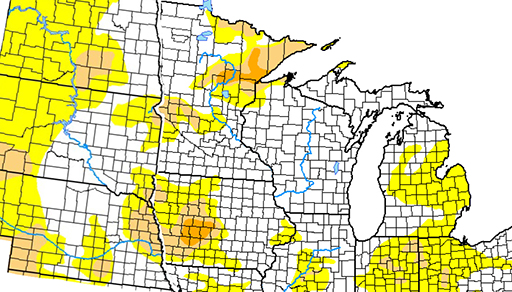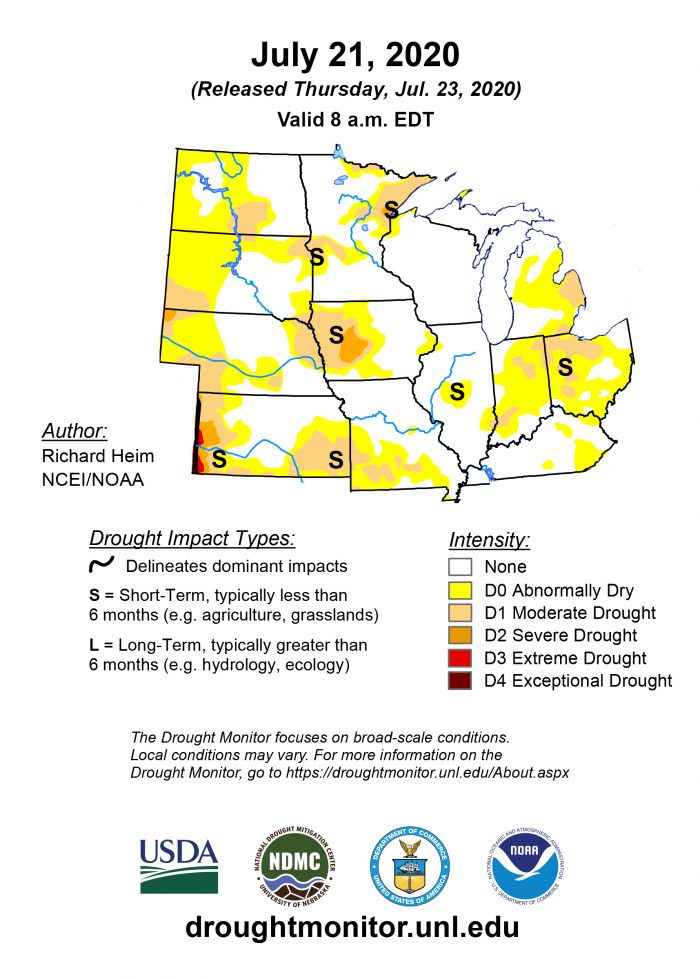by Margaret Smith, PhD Forage Agronomist
Drought Conditions Across the Upper Midwest
Parts of the Upper Midwest have been under pre-drought or drought conditions. Much of the western half of Iowa, central and northeastern Minnesota are either abnormally dry or under drought warning. Other parts of the Midwest have had too much rainfall. If only we could average the weather for these areas! Dry conditions also exist across much of Indiana, Ohio, New York and Pennsylvania. The U.S. Drought Monitor tracks conditions across the U.S. and updates their national maps each week.
Drought map for week of July 21, 2020
Plant response to Drought Conditions and Other Stressors: Accumulation of Nitrate
Certain plants under drought conditions, can accumulate nitrates and become toxic to ruminants (see Table 1 below). Of our major livestock species, cattle are most susceptible to nitrate toxicity, and sheep the least susceptible. Plants respond to drought by conserving water when available soil water is limited. Stomates close to minimize water loss from leaves, and metabolism and growth also may be slowed, yet plants may still take up nutrients through their roots. Other conditions, such as hail damage or low temperatures, also can lead to concentration of nitrates in plants.
Plants usually take up nitrogen from the soil in the form of nitrate (NO3–). During normal plant growth, nitrate is converted rapidly into amino acids and then into plant proteins. When plants are stressed for water, their roots can continue to take up nitrate, particularly when it is readily available, but conversion to amino acids and protein in the plant is slowed. This phenomenon may be particularly evident three to seven days after forages have been under drought conditions and finally get a good rain. Normal growth resumes, but nitrate uptake precedes the conversion to amino acids and protein in the plant leaves. When this happens, nitrate can accumulate in the base of the plants, both in the lower stalks and lower leaves. Plants that have been well fertilized with nitrogen or manure are more likely to accumulate nitrate under these environmental conditions.
Table 1. Plants Known to Accumulate Nitrate
Crop Species |
Weedy Species |
Barley |
Amaranth |
Corn |
Canada thistle |
Flax |
Dock |
Pearl Millet |
Jimsonweed |
Oats |
Johnsongrass |
Radishes |
Kochia |
Rapeseed |
Lambsquarter |
Rye (cereal) |
Nightshade |
Soybeans |
Pigweed |
Sorghum |
Russian thistle |
Sorghum x sudangrass hybrids |
Smartweed |
Sugar beets |
Wild sunflower |
Sweetclover |
|
Sudangrass |
|
Sugar beets |
|
Turnips |
|
Wheat |
High levels of nitrate have also been documented in perennial grasses and alfalfa.
Why is Nitrate Toxic to Ruminants?
Cattle, sheep and goats, when eating forages or weeds or drinking water containing nitrates, convert those nitrates to nitrite, then to ammonia and then bacterial proteins in the rumen. When higher than normal rates of nitrate are ingested, they are quickly converted to nitrites, which can accumulate in the rumen, Nitrites are 10 times more poisonous to ruminants that nitrates. Nitrite is absorbed into red blood cells, where it combines with hemoglobin (which carries oxygen throughout the body) to form methemoglobin. Methemolglobin cannot carry oxygen in the blood, resulting in oxygen ‘starvation’ or suffocation for the animal.
Steps of Nitrate Conversion in the Rumen
Nitrate (NO3–)→Nitrite (NO2)→Ammonia (NH3)→Bacterial amino acids→Bacterial Protein
Symptoms of Nitrate (Nitrite) Poisoning
Nitrate poisoning is usually acute (severe) but may be chronic, or subacute, when lower levels of nitrate are consumed for longer periods of time. Chronic symptoms can be slowed growth, lowered milk production, Vitamin A deficiency, abortions and increase susceptibility to infection. Acute symptoms are more likely following a drought or stress period for plants and with a high percentage of forage intake in the ruminant diet. Acute symptoms are:
- Rapid and difficult breathing, noisy breathing
- Rapid pulse rate (150+ beats/minute)
- Salivation, bloat
- Tremors, staggering
- Weakness, coma, and/or death
In addition, pregnant females that survive acute nitrate poisoning may abort their fetus about 10-14 days following exposure to nitrates.
Diagnosis and Treatment of Nitrate Poisoning
Consult your veterinarian for a definitive diagnosis. Both forage analyses and animal blood samples can be useful for diagnosis.
Managing to Avoid Nitrate Poisoning
If you suspect your forages may have accumulated nitrates before harvest, sample the forages and have them tested, not only for nutrient content and digestibility, but also for nitrates. This is good practice for both forages you plan to graze and those harvested for winter feeding. Guidelines for forage sampling and nitrate levels of concern can be found in the resources from the University of Wisconsin and Pennsylvania State University, listed below.
Grazing Management
Once nitrate levels are known, introduce grazing animals slowly to nigh nitrate paddocks. Make sure animals are well fed before moving them to this new forage. On the first day, allow animals to graze for only ½ to 1 hour. Increase the time grazed each day for 5 to 7 days until they can graze continuously. Remove animals before they graze forages that have experienced stress, particularly annual warm-season grasses, below six inches.
Feeding Stored Forages
Feeding should be managed to include some forages that are lower in nitrate to dilute the potential effect. Some nitrate may have dissipated from silage during fermentation, so sampling near to the time of feeding is best. Unlike prussic acid, which dissipates over time, nitrate levels in dry hay will be maintained through storage. As with grazing, introduce high nitrate forages slowly into the diet. The rate of feed intake and moisture content of stored feeds influence animals’ abilities to handle high nitrate feeds. Nitrate is released faster from dry hay than from silage. Work with a nutritionist to formulate diets that will include high nitrate feedstuffs.
Monitor animal behavior and health closely after introducing them to grazing or stored forages with elevated nitrate levels.
Resources
Nitrate Poisoning and Feeding Nitrate Feeds to Livestock. Barry Yaremcio, Agri-Facts, Albert, Canada
Nitrate Poisoning in Cattle, Sheep, and Goats. Dan Undersander, and others. University of Wisconsin.
Nitrate Poisoning of Livestock. Revised by Janna Block, North Dakota State University
Overview of Nitrate and Nitrate Poisoning. Larry J. Thomsson, Merck Veterinary Manual
Prevention and Control of Nitrate Toxicity in Cattle. Richard S. Adams and Thomas R. McCarty. Pennsylvania State University

